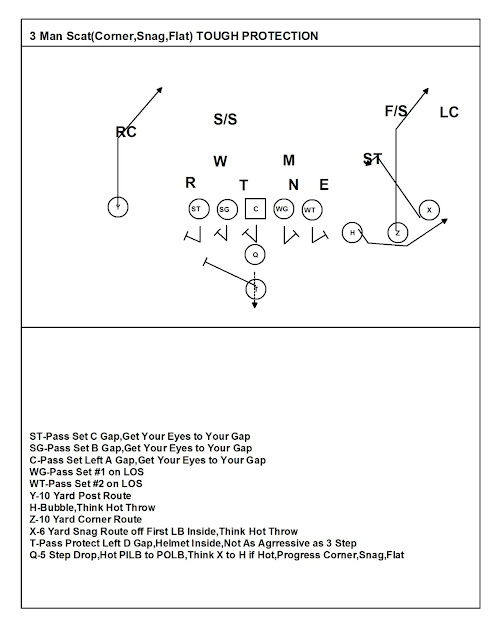 |
| GET THE BALL OUT |
The 3 Step passing game is all about rhythm. The routes and the release of the ball must be timed up exactly in order to effectively execute the quick passing game. Nobody got the ball out quicker than Dan Marino. When I think ball out quick with my QBS I think Dan. The 3 Step game needs to be an extension of your perimeter run game. It should be used not only to convert crucial 3rd and 2-3's but also as a positive first down play that gets you into 2nd and 3-6. I want to take a look at packaging quick game concepts that give a coordinator and a QB the chance to be successful every time the quick game is called.
COVERAGE BEATERS
Lets take a look at packaging coverage beaters in your quick game as opposed to mirrored routes on each side that lead to route conversions and headaches. When I was a young receiver the quick passing game was always mirrored to each side and we had to learn to convert routes based on coverage. That meant the QB and the WR had to be on the same page. I can't tell you how many times I ran Hitch and the QB threw Fade or I ran Fade and the QB threw Hitch. No matter how much time we spent on it there was always a grey area in the game that made it difficult. Good DB'S would stem and jockey their position pre snap and paint a different picture. About 10 years ago I was at a clinic and I heard a guy talking about the quick game and coverage beaters. It made perfect sense to me. It gave the QB the chance to be successful without relying on the route conversion dilemma. Also in the day and age of "up tempo" offenses it gave the coach a chance to call better routes based on the coverage he saw at the line. 30 Years ago we used to call Quick Hitch in the huddle and had no clue what the coverage was going to be. Now when you are on the ball playing at a fast pace you have a better chance to see coverages and make better calls.
 |
| WINNING |
HOW DOES IT WORK?
We want to give the QB a soft coverage beater, and a hard coverage beater. We talk in terms of 1 High and 2 High beaters but in essence it is really beating a soft flat or a hard flat. We like to combine the Hitch routes with backside double Slants. The QB will always check the Hitch Side first and throw that way until the defense absolutely takes it away. I think the Hitch is the highest percentage pass in High School football and a ball almost every HS QB, in every program can throw. If they take the Hitch away then we will progress to the double Slant side. The reason we run double Slant as opposed to Slant Arrow is because the double Slant is a better Cover 2 beater. If they roll up the corners and play hard Cover 2 the slant arrow is a dead play. Will eats up the Slant and the Corner crucifies the Arrow. The double Slant allows you to isolate that Will LB and make him choose the route he needs to defend. If you are getting press man then the double Slant route should be equally as effective. In this scenario I only need my QB to be right, not my QB and my WR to be right. We will NEVER convert 3 step passing game routes. The WRS will run their routes regardless of the coverage they see. The other combination we like to use is the Fade/Vertical on one side and the Out/Hitch on the other side. The Fade side is the Hard coverage beater. The QB will look Fade side first and if it is a Hard coverage he will throw the Fade/Vertical all day. Hard coverage means the DB is up inside of 4 yards from the receiver. It could be Cover 2 or a Man concept but he is up tight. If the coverage is soft with the DB playing off we will throw the Out/Hitch combo to the soft side. Because we are no huddle I have the chance to see the structure of the coverage before I call the play so I can be pretty certain I can call the right combinations. There have been some defenses that have fooled me and the QB and at that point your QB must throw it away or scramble back to the Line of Scrimmage. The quick game needs to consist of high percentage throws, with timing and rhythm being the key. Its a great way to attack weaknesses in defenses while keeping your success rate extremely high.
























